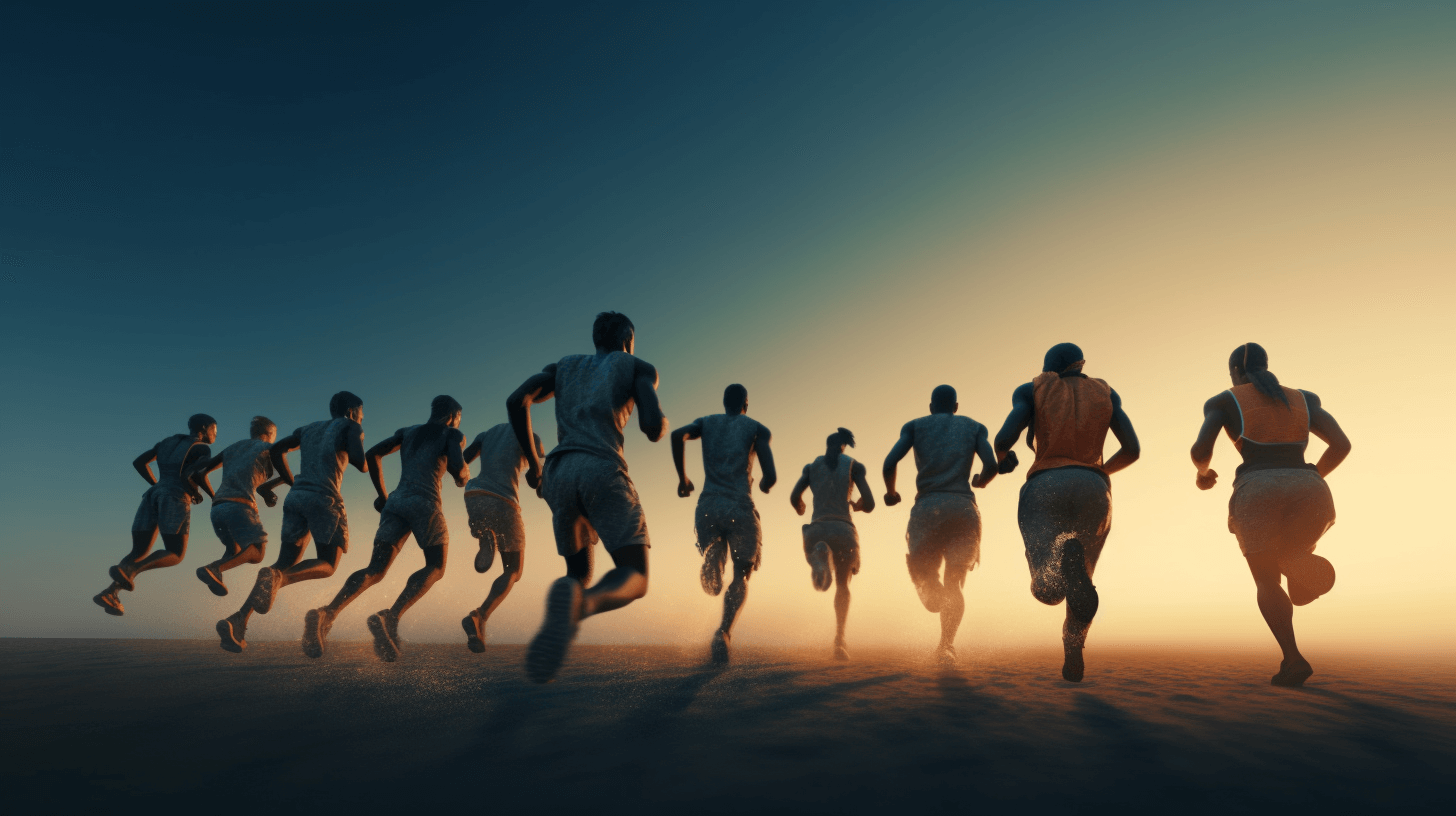💪💙 One Man’s Mission fo’ Make Runnin’ Everyone’s Sport 🏃♂️
Martinus Evans like fo’ make runnin’ mo’ inclusive. His new book beckons back-of-da-packers fo’ lace up. 📚👟
On one recent Sunday mornin’ jog through Prospect Park, Martinus Evans was received like one conquering champion. Every few minutes, one passing runner would smile an’ nod, congratulatin’ him as dey sped by. 🏞️🏃♂️👏
But da runners wasn’t applaudin’ him fo’ winnin’ any races. You might even say dey was celebratin’ him fo’ his track record of finishin’ last. 🏅🐢
Mr. Evans be da founder of Slow AF Run Club, one virtual community fo’ back-of-da-packers wit’ ova 10,000 members worldwide. At 300 pounds, he one beloved figure among runners who felt left outta da sport. He’s graced da cover of Runner’s World, posed nude fo’ Men’s Health, an’ appeared in one Adidas ad. His Instagram account, @300poundsandrunning, has ’round 62,000 followers. An’ dis month, he droppin’ his first book, “Slow AF Run Club: Da Ultimate Guide fo’ Anyone Who Wants to Run.” 📖🌍📸
Da idea fo’ da club was born ’bout mile 16 of da 2018 New York City Marathon, jus’ afta da gruelin’ Queensboro Bridge into Manhattan. Mr. Evans was cruisin’ along when he noticed one man gesturin’ from da sidelines. He took out his AirPods. 🏃♂️🌉🎧
“You’re slow, buddy,” da man shouted, addin’ an expletive to indicate jus’ how slow. “Go home.” Mr. Evans tried to ignore him, an’ turned his attention back to da course, which he eventually finished in jus’ ova eight hours, or six hours behind da winner. But as da bystander repeated his taunt, Mr. Evans got angrier—den inspired. 😠🔥💡
Da next time Mr. Evans, now 36, raced, he wore one shirt emblazoned wit’ da man’s phrase, SLOW AF, an’ one cartoon of one smilin’ turtle. When he shared photos of his new racin’ uniform on Instagram, followers asked fo’ shirts of their own. By early 2019, one runnin’ club was born. 🐢🐢🐢
Mr. Evans, who lives in Brooklyn an’ now be one certified runnin’ coach, helpin’ lead one global movement fo’ make da sport feel safe an’ welcomin’ fo’ anyone who wants to run, whateva dey size, pace, fitness level, or skin color. He said his drivin’ message simple. “I want everyone to know that they can run in da body they have right now.” 🌍🤝🏃♂️💙
“Mr. Evans, you stay fat.” 🙄
Growin’ up on da east side of Detroit, da son of two auto factory workers, Mr. Evans, who Black, neva know anyone who ran fo’ fun. Most people he knew thought of recreational runnin’ as one white person’s activity.
As one boy, he was mocked fo’ his size—he was known in da neighborhood as “Marty da fat kid,” he said. When he tried out fo’ one youth football team, da coach made him wear one garbage bag on da field to “sweat out da fat,” he said. He neva lost weight; he jus’ felt ashamed. 😔🚫🍔
But afta makin’ his high school’s football team, he began to develop confidence in his physical abilities. He attended Lane College in Tennessee on one football scholarship, befo’ transferrin’ to Central Michigan University, where he majored in exercise science. “I was like, maybe I’ll finally learn how to work out an’ lose dis weight,” he said. “An’ den I can finally be accepted.” 💪🎓🏈
In 2012, Mr. Evans an’ his then girlfriend (now wife) moved to Connecticut, where she had gotten into graduate school. He took one job sellin’ suits at Men’s Wearhouse while he figured out his next move. Da job, which required him to dress men of all ages an’ body types, would provide one unlikely path to becomin’ one fitness influencer. 💼👔👟
Afta months on da storeroom floor wearin’ stiff dress shoes, he began to feel an ache in his hip. Da pain brought him to one orthopedic surgeon, who, he writes in his book, took one look at him an’ told him: “Mr. Evans, you stay fat. You get two options: Lose weight or die.” 💔🏥🩺
Mr. Evans remembered holdin’ back tears while, “wit’ one half-cocked smile,” defiantly tellin’ da doctor, “I’m goin’ run one marathon.” He said da doctor laughed an’ told him runnin’ one marathon would also kill him. He left da appointment angry an’ still in pain (anotha physician later diagnosed him wit’ hip bursitis) an’ drove straight to one runnin’ store fo’ buy one pair of trainers, determined fo’ prove da doctor wrong. Fo’ extra motivation, Mr. Evans started one blog he called 300 Pounds and Runnin’, where he began to track both his runnin’ progress an’ weight loss. Afta few months, he was surprised fo’ discover strangers was readin’ an’ cheerin’ him on. 💪👟💻📈
He found dat he enjoyed runnin’, despite da occasional insults from passers-by. Mo’ dan once, Mr. Evans said he been stopped an’ questioned by police while joggin’. When he felt defeated, he’d glance at one tattoo on his right wrist dat reads “no struggle, no progress.”
Eventually, he ran one 5K, den one half marathon. Finally, in da fall of 2013, Mr. Evans flew home fo’ run da Detroit Free Press Marathon an’ fulfill his vow in da doctor’s office. When he crossed da finish line, he wept. 😢🏅🏁
Since den, he got one master’s degree in public health research an’ anotha in digital media an’ design. He said runnin’ gives him one sense of self-determination, confidence, an’ purpose. An’ while it initially helped him lose ’bout 90 pounds, takin’ him below 300 fo’ one time, he realized dat runnin’ to lose weight took away from da satisfaction. “I wasn’t 90 pounds happier,” he said. He decided fo’ stop countin’ calories an’ run just fo’ fun.
He remembered dat what made him one successful salesman at Men’s Wearhouse was da ability to help customers feel good jus’ as dey was. He suspected otha runners could benefit from focusin’ on da joy of da sport ova weight loss. On his blog, he leaned into his persona as one 300-pound runner.
“Mo’ Struggle, Mo’ Progress” 💪🔥📈
Historically, da sport of runnin’ made many people in big bodies feel like dey had to lose weight fo’ belong—to be considered real runners, said Samantha White, one assistant professor of sport studies at Manhattanville College. By “amplifyin’ runners who not focused on time, but ratha on community,” she said, Mr. Evans creatin’ one space “where recreational runners, especially Black recreational runners, can find one place.”
As such, da first rule of Slow AF Run Club, which mostly exist on one app wit’ da same name, dat members can’t talk ’bout deir weight or weight loss.
“It one judgment-free zone,” said Jetaun Pope, 42, one high school algebra teacher in Chicago who one long-time member an’ helps moderate da club’s online discussions. “It feel good fo’ feel like you’re not alone,” she said. “Da mo’ you see people in all bodies” bein’ active, da mo’ “it encourage you fo’ take da first step.”
Da club’s app free fo’ join; Mr. Evans make his livin’ through coachin’ sessions, merchandise sales, an’ brand partnerships. He also workin’ fo’ convince race directors fo’ keep water stations an’ finish lines intact fo’ back-of-da-pack runners, an’ athletic wear brands to include one wider range of sizes.
When counselin’ runners, Mr. Evans advise dat, ‘fore even slip on shoes, dey should focus on retrainin’ deir brains to adopt da mindset dat dey can run, despite what one thin-obsessed, speed-focused culture might say. In his book, he encourage dem to neutralize deir inner critic by namin’ it—his one called Otis, which he imagine like one “ignorant, drunk uncle.” Lastly, he tell runners to move forward howeva dey can, even if it requires what he call “delusional self-belief.”
On one practical level, he recommend dat people run ’bout 70 to 80 percent of da time at what he call “sexy pace”—”da pace you’d go if you was runnin’ in slow motion on one beach,” Baywatch style—or what most otha coaches call conversational speed. Startin’ out, he suggest runnin’ fo’ 15 seconds an’ den walkin’ fo’ 90 seconds. Den ova twelve weeks or so, progress to five minutes of runnin’ an’ one minute of walkin’.
“Start slow an’ enjoy da journey,” said Anne Brady, one professor of kinesiology at da University of North Carolina-Greensboro. “It all ’bout consistency. So you gotta start wit’ somethin’ you can sustain in one short bout.” She also advised dat larger people carefully select supportive, comfortable footwear to reduce impact on deir joints.
Mo’ dan one decade afta he took up runnin’, wit’ eight marathons under his belt, Mr. Evans still 300 pounds. He healthy by all da usual measures, though he no measure his well-bein’—or success as one runner—in numbers. He run simply fo’ be able to keep runnin’, fo’ himself an’ fo’ others. Da longer he show up an’ run slow AF, he said, da easier it become fo’ otha runners fo’ do da same. 🏃♂️💙🌟
NOW IN ENGLISH
💪💙 One Man’s Mission to Make Running Everyone’s Sport 🏃♂️
Martinus Evans wants to make running more inclusive. His new book beckons back-of-the-packers to lace up. 📚👟
On a recent Sunday morning jog through Prospect Park, Martinus Evans was received like a conquering champion. Every few minutes, a passing runner would smile and nod, congratulating him as they sped by. 🏞️🏃♂️👏
But the runners weren’t applauding him for winning any races. You might even say they were celebrating him for his track record of finishing last. 🏅🐢
Mr. Evans is the founder of Slow AF Run Club, a virtual community for back-of-the-packers with over 10,000 members worldwide. At 300 pounds, he is a beloved figure among runners who have felt left out of the sport. He’s graced the cover of Runner’s World, posed nude for Men’s Health, and appeared in an Adidas ad. His Instagram account, @300poundsandrunning, has around 62,000 followers. And this month, he’s releasing his first book, “Slow AF Run Club: The Ultimate Guide for Anyone Who Wants to Run.” 📖🌍📸
The idea for the club was born around mile 16 of the 2018 New York City Marathon, just after the grueling Queensboro Bridge into Manhattan. Mr. Evans was cruising along when he noticed a man gesturing from the sidelines. He took out his AirPods. 🏃♂️🌉🎧
“You’re slow, buddy,” the man shouted, adding an expletive to indicate just how slow. “Go home.” Mr. Evans tried to ignore him and turned his attention back to the course, which he eventually finished in just over eight hours, or six hours behind the winner. But as the bystander repeated his taunt, Mr. Evans got angrier—then inspired. 😠🔥💡
The next time Mr. Evans, now 36, raced, he wore a shirt emblazoned with the man’s phrase, SLOW AF, and a cartoon of a smiling turtle. When he shared photos of his new racing uniform on Instagram, followers asked for shirts of their own. By early 2019, a running club was born. 🐢🐢🐢
Mr. Evans, who lives in Brooklyn and is now a certified running coach, is helping lead a global movement to make the sport feel safe and welcoming for anyone who wants to run, whatever their size, pace, fitness level, or skin color. He said his driving message is simple. “I want everyone to know that they can run in the body they have right now.” 🌍🤝🏃♂️💙
“Mr. Evans, you’re fat.” 🙄
Growing up on the east side of Detroit, the son of two auto factory workers, Mr. Evans, who is Black, didn’t know anyone who ran for fun. Most people he knew thought of recreational running as a white person’s activity.
As a boy, he was mocked for his size—he was known in the neighborhood as “Marty the fat kid,” he said. When he tried out for a youth football team, the coach made him wear a garbage bag on the field to “sweat out the fat,” he said. He never lost weight; he just felt ashamed. 😔🚫🍔
But after making his high school’s football team, he began to develop confidence in his physical abilities. He attended Lane College in Tennessee on a football scholarship before transferring to Central Michigan University, where he majored in exercise science. “I was like, maybe I’ll finally learn how to work out and lose this weight,” he said. “And then I can finally be accepted.” 💪🎓🏈
In 2012, Mr. Evans and his then-girlfriend (now wife) moved to Connecticut, where she had gotten into graduate school. He took a job selling suits at Men’s Wearhouse while he figured out his next move. The job, which required him to dress men of all ages and body types, would provide an unlikely path to becoming a fitness influencer. 💼👔👟
After months on the storeroom floor wearing stiff dress shoes, he began to feel an ache in his hip. The pain brought him to an orthopedic surgeon, who, he writes in his book, took one look at him and told him: “Mr. Evans, you’re fat. You have two options: Lose weight or die.” 💔🏥🩺
Mr. Evans remembered holding back tears while, “with a half-cocked smile,” defiantly telling the doctor, “I’m going to run a marathon.” He said the doctor laughed and told him running a marathon would also kill him. He left the appointment angry and still in pain (another physician later diagnosed him with hip bursitis) and drove directly to a running store to buy a pair of trainers, determined to prove the doctor wrong. For extra motivation, Mr. Evans started a blog he called 300 Pounds and Running, where he began to chart both his running progress and weight loss. After a few months, he was surprised to discover strangers were reading and cheering him on. 💪👟💻📈
He found that he enjoyed running, despite the occasional insults from passers-by. More than once, Mr. Evans said he has been stopped and questioned by police while jogging. When he felt defeated, he’d glance at a tattoo on his right wrist that reads “no struggle, no progress.”
Eventually, he ran a 5K, then a half marathon. Finally, in the fall of 2013, Mr. Evans flew home to run the Detroit Free Press Marathon and deliver on his vow in the doctor’s office. When he crossed the finish line, he wept. 😢🏅🏁
Since then, he’s gotten a master’s degree in public health research and another in digital media and design. He said running offers him a sense of self-determination, confidence, and purpose. And while it initially helped him lose about 90 pounds, taking him below 300 for a time, he realized that running to lose weight took away from that satisfaction. “I wasn’t 90 pounds happier,” he said. He decided to stop counting calories and run just for fun.
He remembered that what made him a successful salesman at Men’s Wearhouse was the ability to help customers feel good just as they were. He suspected other runners could benefit from focusing on the joy of the sport over weight loss. On his blog, he leaned into his persona as a 300-pound runner.
“No Struggle, No Progress” 💪🔥📈
Historically, the sport of running has made many people in big bodies feel like they have to lose weight to belong—to be considered real runners, said Samantha White, an assistant professor of sport studies at Manhattanville College. By “amplifying runners who aren’t focused on time, but rather on community,” she said, Mr. Evans is creating a space “where recreational runners, especially Black recreational runners, can find a place.”
As such, the first rule of Slow AF Run Club, which exists primarily on an app by the same name, is that members can’t talk about their weight or weight loss.
“It is a judgment-free zone,” said Jetaun Pope, 42, a high school algebra teacher in Chicago who is a longtime member and helps moderate the club’s online discussions. “It feels good to feel like you’re not alone,” she said. “The more you see people in all bodies” being active, the more “it encourages you to take the first step.”
The club’s app is free to join; Mr. Evans earns a living through coaching sessions, merchandise sales, and brand partnerships. He also works to persuade race directors to keep water stations and finish lines intact for back-of-the-pack runners and athletic wear brands to include a wider range of sizes.
When counseling runners, Mr. Evans advises that, before even slipping on shoes, they should focus on retraining their brains to adopt the mindset that they can run, despite what a thin-obsessed, speed-focused culture might say. In his book, he encourages them to neutralize their inner critic by naming it—his is called Otis, which he imagines like an “ignorant, drunk uncle.” Lastly, he tells runners to move forward however they can, even if it requires what he calls “delusional self-belief.”
On a practical level, he recommends that people run about 70 to 80 percent of the time at what he calls “sexy pace”—”the pace you’d go if you were running in slow motion on a beach,” Baywatch style—or what most other coaches call conversational speed. Starting out, he suggests running for 15 seconds and then walking for 90 seconds. Then over twelve weeks or so, progress to five minutes of running and one minute of walking.
“Starting gradual is great,” said Anne Brady, a professor of kinesiology at the University of North Carolina-Greensboro. “It’s all about consistency. So you have to start at something that you’re able to sustain in a short bout.” She also advised that larger people carefully select supportive, comfortable footwear to reduce impact on their joints.
More than a decade after he took up running, with eight marathons to his name, Mr. Evans is still 300 pounds. He’s healthy by all of the usual metrics, though he doesn’t measure his well-being—or success as a runner—in numbers. He runs simply to be able to continue running, for himself and for others. The longer he shows up and runs slow AF, he said, the easier it becomes for other runners to do the same. 🏃♂️💙🌟







